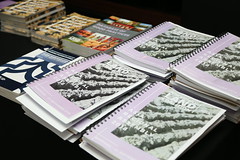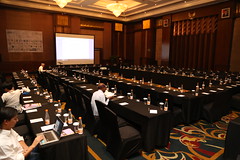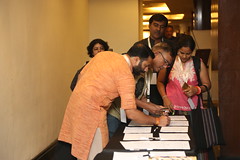SOURCE: Kapaeeng Foundation
As a part of preparation for the 21st session of Conference of Parties (COP21), a national workshop on climate change and dialogue with the government was held on 9 September 2015 at YWCA conference hall of Asad Avenue in Dhaka. The event was organised by Indigenous Peoples National Coordination Committee (NCC) for Climate Change.
The main objectives of the preparatory meeting are to discuss major impacts of climate change on indigenous peoples’ life and livelihood, and accordingly prepare a country report on the situation of indigenous peoples and climate change to be shared in the forthcoming regional workshop in Chiang Mai. Further, having a dialogue with the government representatives and sharing outcomes of the workshop aimed at to pursue the government to include identified specific recommendations in national report for COP21.
The meeting was attended by indigenous representatives from different regions of Bangladesh, including members of NCC, representatives of youths and women and experts of environment, parliamentarian, teacher and government representatives from Ministry of Forest and Environment.
The morning session was started with the welcome speech by Mr. Sanjeeb Drong General Secretary of Bangladesh Indigenous Peoples Forum while Pallab Chakma Executive Director of Kapaeeng Foundation conducted the session. In his speech Sanjeeb Drong said climate change is the new issue for indigenous peoples in Bangladesh. To address the issues regarding the climate effect at national and international level, indigenous youth should come forward and build expertise on them on climate change related issues. Professor Gonesh Saren of BIPNet, Mangal Kuumar Chakma, advisor of Kapaeeng Foundation, Janalal Chakma, executive director of CIPD, Helena Talang of KUBORAJ, Uchacha A Chak, from Maleya Foundation were also present among others.
Alexius Chicham, National Coordinator, Indigenous Peoples Program of ILO presented the draft country report of indigenous peoples of Bangladesh on climate change for COP21. In his report he stated with the current situation and impacts of climate change in indigenous peoples’ area and how they facing the impacts of climate change and what are the actions could be taken on combating climate change impacts. He also mentioned the need and priorities of indigenous peoples to cope up with climate change. Beside that he also discussed the policies, measures and programmes of government in relation with climate change. Finally, he has shared some recommendations for government on climate change and for COP21 particular to address indigenous peoples issues.
After the presentation on draft country report the indigenous peoples from different regions have taken part in an open discussion to address their problems which is not added in the paper. They have also given some substantive suggestions on the draft report.
Mr. Alamgir Hossain, Program Analyst (Environment) of UNDP, gave a presentation on development of climate change negotiation and Bangladesh government’s position.
The afternoon session was the interactive dialogue with honorable guest and government representatives. In this session Mr. Ushantan Talukdar, Member of Parliament (MP) and member of parliamentary standing committee on Ministry of CHT Affairs & member of Parliamentary Caucus on Indigenous Peoples Issues; Professor Dr. Sadeka Halim, former information commissioner; Government representatives of Bangladesh – Mr. QSI Hasmi, Additional Director General, Department of Environment, and Mr. Rezaul Shikdar, Conservator of Forest (administration and finance) forest department of Ministry of Environment and Forest were present and delivered their speeches. The whole session was conducted by Sanjeeb Drong, General Secretary of Bangladesh Indigenous Peoples Forum.
This session was interactive dialogue where indigenous peoples and honorable guest discussed the issues of climate change and its impacts of indigenous peoples area. Indigenous peoples raised their problems and issues regarding climate change impacts. Beside that they raised many issues related to environment pollution and deforestation in their area. Honorable guests have also taken part in the session and assured to provide all necessary cooperation from the Ministry of Forest and Environment to address the raised issues.
Finally, indigenous people urged to government to follow free prior informed consent before adopting any policy that influence the life of indigenous peoples in Bangladesh. They also requested to the government representatives to consider indigenous peoples’ issues in formulating country report for COP21. Government representatives promised to incorporate the raised points including mitigation and adaptation measures, technology development and transfer, finance and capacity building for addressing climate change impacts of indigenous peoples in the country report for COP21 which will be presented in Paris.
The country report on climate change stated that Bangladesh government has established the “Bangladesh Climate Change Trust Fund (BCCTF) with national revenue budget and “Bangladesh Climate Change Resilience Fund” (BCCRF) and is also getting fund from the Climate Investment Fund (CIF).
The BCCTF has 236 projects as of 2014 out of which several projects have direct impact on the indigenous peoples of Modhupur, Northern districts and CHT. For instance; “Re-vegetation of Modhupur Forest through Rehabilitation of Forest Dependent Local and Ethnic Communities” phase-1 and phase-2 projects directly violated the human rights of indigenous peoples in Modhupur. As the project has been implemented as part of climate change mitigation measures under the BCCTF, there was no proper consultation with indigenous peoples and did not follow the principles of Free, Prior, Informed Consent (FPIC). Rather the projects acquired indigenous peoples’ communal lands.
Similarly indigenous peoples of the Northern districts (known as Barind Tract) especially Noagoan and Rajshahi district, who are the victims of drought and low erratic rainfall, have no equal access to the projects implemented under the BCCTF for creating water reservoirs and extracting ground water for irrigation and environment development. Thus indigenous communities are not able to seize the benefits of such government adaptation programmes.
The adverse impacts of climate change in CHT will only increase further political migration, forcible land grabbing and discrimination in employment and occupations, including shifting cultivation in CHT. The mind-set of the mainstream population and the policy makers who blame jum cultivation for loss of biodiversity and forest degradation has not changed. Natural resource management policies are also not in favour of the jumias and as such, natural resources are rapidly deteriorating leading to soil erosion and the loss of biodiversity. Thus the traditional jum cultivation on the traditional lands are under threat of transferring into commercial cash crops and other development purposes.
Moreover indigenous peoples in CHT and Plains region face forced evictions or displacement from their ancestral lands as a result of mitigation measures such as reserved forest, national park, eco-park and armed forces base. Such development initiatives weaken or impair the capacity to deal with climate induced hazards and vulnerabilities. Climate induced vulnerabilities are not equally distributed between and even within communities and often indigenous women (CHT and Plains) are disproportionally affected by climate change impacts. Water shortage forces women to search for water sources in long distances from their homes. In case of emergency, they are often left behind as they face prohibitions to leave the house unaccompanied, or because they have to care for the children and the elderly.
There are some more projects which are implemented under the BCCTF for instance, “Community Based-Adaptation in the Ecologically Critical Areas through Biodiversity Conservation and Social Protection project and Solar Energy Development in the Climate Vulnerable Areas of Bangladesh project” including CHT hardly covered indigenous peoples as beneficiaries or consulted the impact of such projects in their traditional livelihood.
The indigenous peoples in the southern parts are also vulnerable to impacts of climate change. The severity and intensity of tidal surges, cyclones, salinity intrusion and water logging jeopardized the livelihood of indigenous peoples. Although government has plenty of climate change adaptation programmes in these districts but indigenous peoples could hardly identify them as beneficiaries nor represented any of the project related meetings. After SIDR 2007 and AILA 2009 cyclones, Bagdi and Munda indigenous communities who are dependent on honey and crab collection from the Sundarban have squeezed or altered their livelihood pattern for instance some of them migrated to cities for better future. In the same way, Rakhaine indigenous community lost their arable lands due to salinity intrusion and lost their traditional natural foods due to impacts of climate change.
The climate change impacts are endangering the resilient capacity of indigenous communities including their social cohesion, adaptation capacity and overall wellbeing. But there is no comprehensive and inclusive indigenous people’s actions and plans towards combating climate change impacts in Bangladesh. The issue of the indigenous peoples’ Actions and Plans has been mixed up with the Bangladesh government’ “Bangladesh Climate Change Strategy and Action Plan 2009” which does not explicitly reflect the indigenous peoples’ issues, rights and vulnerabilities to face the brunt of climate change induced disasters. Thus their plans and actions are not visible in the national context as well as in the global level.
However indigenous peoples of Bangladesh with support of AIPP and National Coordination Committee in June 2014, organized a national consultation on REDD+ Dhaka. The Declaration of 2014 on the proposed REDD+ initiative in Bangladesh and related matters, is one of the consensus recommendations for combating climate change impacts at local, national and global level. There are few supports from different development organizations which helped indigenous peoples to exercise their community based adaptation actions and plans. The small actions and plans might reduce residual risks and hazards but lasting and sustainable adaptation actions and plans required support from the government. This can be subsidized from the BCCTF, BCCRF and CIF.
The recognition of communal land rights/traditional lands rights (including right to traditional jum cultivation) is the first and foremost need to face the brunt of climate change induced disasters. Indigenous peoples’ key needs and priority compounded to protect, conserve and sustainably use community-managed and other forest lands. Still indigenous peoples have insufficient information and understanding about the scale of impact of climate change induced disaster, out of social safety net coverage, communication & transportation, quality education, market linkage, human development capitals, so such projects and interventions need to be implemented to make more resilience capacity of indigenous peoples in Bangladesh. Overall, implementation of CHT Accord of 1997, integration and amendment of existing policies and laws related to indigenous peoples will be the cornerstone to create a pathway of building resilient indigenous communities in Bangladesh.
The following key recommendations, among others, can be an adding value to the government’s key strategies to develop their position paper before COP21-
- For CHT, mitigation option is to limit the climate change-induced increase in frequency and intensity of landslides by stopping the ongoing deforestation, of which some is legal and some illegal and recognition the jum cultivation (shifting cultivation)
- Mobilize carbon credits from the UNFCC Considering the geographic remoteness (CHT, some parts of plains) the renewable energy particularly solar homes and biogas plants which will contribute to low-carbon future
- Respect the Free Prior Informed Consent (FPIC) principles in designing, implementing, monitoring the development projects related to climate change mitigation program (social forestry) on government and indigenous community land.
- Recognition of communal land rights of indigenous peoples (CHT and Plains) will be the entry point for applying traditional knowledge, crop diversifications in their Jum and lands by the local experts in changing climate
- Altering land use pattern (CHT and Plains) in changing climate through intensive and semi-intensive integrated crops and livestock and re-settlements of political migrants will develop the resilient capacity of ecology and indigenous peoples in CHT and Plains
- Full implementation of CHT Accord of 1997 with transfer of 33 subjects including Forest and Environment to three Hill District Councils will be the cornerstone for taking adaptation measures to face the brunt of climate change in the CHT
- Recognition of the roles and contributions of indigenous women in forest resource management in changing climate, thereby requiring their full and effective participation in all decision-making bodies and processes relating to forests including Non-Carbon Benefits and natural resources
- Create water reservoirs for agro-based dependent indigenous peoples in the drought prone areas (Northern districts) through excavation and re-excavation of ponds and canals to harvest rain water with special allocations from government’s Trust and Resilient Funds
- Traditional management of streams (locally known as sora) protection by the indigenous communities for maintaining water flow and managing watersheds in the CHT should also be financed from the available funds
- Regional action plan considering 30 agro ecological zones to adapt with climate change
- Immediate Review, amend state policies and laws related to the practice of shifting cultivation in changing climate, implement CHT Land Dispute Resolution Commission Act 2013 and new laws and commission for plain indigenous peoples.
- Identify the appropriate methodologies to assess residual losses and damages of indigenous peoples due to climate change and related loss of income, biodiversity and ecosystem (economic) and damage of property and assets, cultural, social and mental impacts (non-economic) of climate change and appropriate measures to integrate into the national climate change adaptation plan and include as negotiation agenda in the climate change conference (COP21).
- Recognize and measures for indigenous peoples’ traditional knowledge linked with nature and behaviors of animals as well as the conditions of nature elements using as the early warning system.
- Allocating and increasing fund allocation in indigenous-inhabited areas: increase grants for Plains IPs; provide CC-related funding to IP-led institutions, organizations and networks.
- Ensure inclusion of indigenous peoples rights, issues, participation and coordination in the upcoming climate conference in Paris (COP21).
- Organizational, logistical and other support to indigenous peoples-led institutions, organizations and networks.
- Sensitize GOB institutions (MOEF, MOCHTA, PMO, other Line Ministries on IP-Vulnerability and Development Issues.
Read Full Post »














